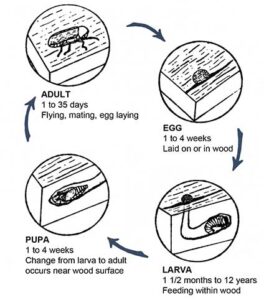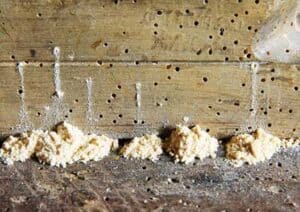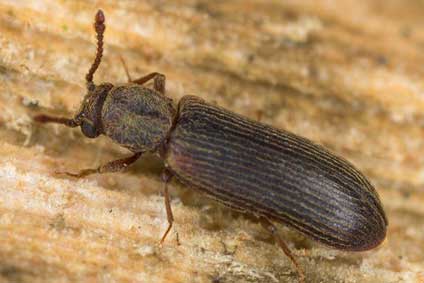New York is the home to some old houses. For fans of older homes, not only do they look fantastically eclectic, but with little work, they look like a page out of a Victorian novel. This character is probably one of the reasons why older homes are popular. Homeowners are always excited to find these homes in the listings. They always jump to buy them before they go off the market. But if you own or are purchasing an older home, you may want to discuss powderpost beetles with your home inspector or realtor.
Old homes can be housing for termites, carpenter ants, and powderpost beetles. These pests are a nuisance across America, Europe, Asian Countries, and even colder regions. Unfortunately, unlike other insects, the harsh weather conditions do not deter them. The good news is that these pests will not be the reason to pack up and move homes, if you are vigilant with the initial signs and traces. Before buying an old home, homeowners should book an appointment with an expert powderpost beetle exterminator. They can come and have a look for any signs of the pests and the damage it has caused.
With some precautionary measures, you can save some severe damage to the foundations of your newly bought property. Let’s learn about these pests, their patterns, how to identify their presence in your homes, and how to get rid of them.
What Are Powderpost Beetles?
The powderpost beetles come from the family of woodboring beetles from the subfamily of Lyctinae. Unlike other woodboring beetles, they have small prothorax, making their head look prominent. When a house has an infestation, you hardly see them. The only indication of an infestation is the powder-like tiny mounds near holes in the wood. If the basement or foundation has an infestation, you may miss the signs of an invasion. They can quietly eat away the wood for years without homeowners even realizing it. Hence, we will explore and learn more about these pests and their behavior.
Some Eerie Facts About Powderpost Beetles
Insect extermination starts from where you understand their lifestyle, behavior, and infestation pattern. In this context, the following facts will help you a great deal when looking to get rid of powderpost beetles:
- The powderpost beetle larvae eat the wood, not the adult beetle.
- Powderpost beetles travel in the wood, reaching homes inside the furniture and lumber.
- They infest oak, pine, and various hardwoods.
- Some species do not infest on wood with low starch and sugar composition.
- They are often mistaken for the weevils, grain beetles, drugstore, or cigarette beetles which infest food only.
Life Cycle of Powderpost Beetles

It is common for powderpost beetles to emerge sometime during summers. It is around the time when the female powderpost beetles lay eggs on the wood pores. The eggs then hatch into the famous C-shaped larvae that dig into the wood and start eating the wood. Gradually the larvae keep eating the wood forming the galleries and leaving behind powder. When you haggle the wood, you find the powder falling from the shot holes. These shot holes indicate larvae formed into an adult beetle and are out on the wooden post to mate or lay eggs. The shot holes look the size of a pin hammered into the wood.
The larvae usually take years and stay inside the lumber, eating away the wood. It only emerges after a couple of years near the wood’s edge when developing into a pupa. The pupa then comes out of the wood forming the shot holes that indicate the exit of a fully-grown beetle. The female beetle then lays somewhere between ten to fifty eggs per female. The eggs then stay on the surface for up to four weeks to hatch into larvae and dig the hole to eat the wood. The fully grown beetle emerges sometime near Winter, but this trait is not necessary for all species.
Types of Powderpost Beetles
There are three types of powderpost beetles. Lyctids, bostrichids, and anobiids. They have a difference in traits and habitats.
Lyctids
Lyctids are more petite in appearance with narrow reddish-brown bodies. Their shot holes are about the size of a pinhead. The powder they leave behind appears like talcum powder or flour. They prefer to infest only the hardwood such as oak, cherry, hickory, walnut, and ash. The infestation can be wood panels, windowpanes, molding, flooring, furniture, and door frames. The only positive thing about lyctids is they do not infest larger pieces such as beams, studs, joists, etc. Hence find yourself lucky when lyctids are infesting the wood as they will not cause damage to the structure.
The reason for not infesting the structures is the nature of wood (i.e., softwood). The softwood has low starch and sugar, which is not enough for the development of the larvae—the starch content in the wood declines as the lumber ages. Hence the female beetle will not lay eggs on the softwood. Drying the hardwood before transportation and bad storage practices are the main reasons for lyctids infestation.
Bostrichidae
Bostrichidae (or Bostrichids) has a flattened and narrower body structure with the head sloping downwards. Some species also have a spine-like projection at the end of the body. They are more significant than lyctids, reddish-brown and black. Female bostrichids lay eggs just like lyctids boring into the wood. However, the powder larvae leave behind has a meal-like texture than the talcum powder-like texture in lyctids. Hence you will not see much powder coming out of the holes due to the surface.
Bostrichidae have a penchant for hardwood. They also infest the newly processed woods with rich starch and sugar count. Therefore, you will find the softwood in the house at little to no risk in the presence of bostrichids. It is likely for the bostrichids to re-infest the wood as the first generation develops into an adult beetle. It can cause severe damage to the wood, as the second round of infestation can be larger than the first encounter.
Anobiid
Unlike the other two kinds, anobiids aren’t picky and infest hardwood and softwood. They are small convex-shaped reddish-brown insects and prefer to invade the wood with 13-30% moisture. This moisture is necessary for the development of larvae.
Anobiid is famous for its severe damage to the structures of homes. They prefer to infest the beams, joists, and other significant components when they have a choice. Since larvae thrive in moist woods, the beams with moisture may experience severe damage. The usual spaces to find anobiid powderpost beetles are basements, garages, and outbuildings. That’s because these spaces have particular dampness in their structures. They cause devastating damage to damp crawl spaces in buildings with central heating and cooling systems installed.
Since they aren’t a particular species, they can survive on cellulose without sugar and starch in the wood. So, it’s most likely they can devour the already infested and old wood that doesn’t have many nutrients for larvae growth. So even if the homes are centuries old, the anobiid will continue to infest the structure of the houses. Since the conditions aren’t ideal for larval development, it may take larvae three years or more to develop into the pupa. Subsequently, it is safe to assume that infestation has been in the structure for roughly ten years.
Recommended Practices From Powderpost Beetle Exterminators
Some practices are essential for homeowners since the fault lies with the wood manufacturer, constructor, installer, or supplier eight out of ten times.
- If the wood is varnished, stained, or painted – the chances of infestation reduce significantly.
- The storage of wood products should comply with all best practices to avoid infestation.
- The manufacturer and constructor need to pay heed to the lumber received.
- If you suspect any intrusion, wood treatment is essential to avoid damage.
- Female beetle doesn’t lay eggs on varnished, painted, or stained wood. Hence if previously infested.
- Check for the signs of any shot holes. Sealing the holes will break the routine. If the wood was previously infested post varnish, the beetle could re-enter the spot to lay eggs and cause reinfestation.
- Call the experts to inspect. If the beetles are infesting, replace the wood with a new one. Also, replace the adjacent panels if you suspect lyctids or anobiid powderpost beetles.
- Constructors and suppliers use methods of kiln-drying and air-drying the wood. The treated wood is exposed to extreme temperatures for hours that diminish the possibility of beetles, bed bugs, or other pests.
- If any small article is thought to have an infestation, placing it in a deep freezer for days, depending on thickness, will also eradicate the beetles.
- Covering the structures with polyethylene sheets eliminates the chances of moisture depositing in the structures due to heating and cooling systems.
How to Identify Powderpost Beetles?
Finding powderpost beetles and their infestation can be tricky for homeowners. However, the following signs may help you identify these species:

- The famous shot holes on the lumber, furniture, windowpanes, wood frames, and floorboards
- The mealy or flour-like powder near the shot holes
- They enjoy sunlight and may occasionally make an appearance during the day
- If you knock on wood, it may sound hollow
Getting Rid of the Powderpost Beetles
There are some ways to rid these creepy crawlers from your home. They do not harm humans but cause severe damage to the structure. Insecticides such as borates are adequate to get rid of the beetles. Borate sprays can penetrate within the wood and kill the pest immediately. Due to the shot holes, the spray reaches and kills the larvae and eggs to eliminate the colonies.
If the wood has a higher moisture content, the borate will penetrate deeper into the wood, becoming more effective. But this becomes useless if the wood is finished with varnish or paints. In that case, borate will not be able to penetrate and reach all larvae. Hence, some treatment plans have a protocol of sanding the surface before spraying borate. Another option that is effective and 100% is fumigation. But it needs to be handled with care by professionals only. The house or building has to the sealed with tarps. The occupants must leave the premises for three days until professionals access if the belief is ventilated and suitable for occupancy.
After rigorous exposure to gases and blasting chemicals, the chances of larvae living on diminishes. Later they seal the holes to discourage any beetle from entering or exiting. Finally, the lumber and furniture can be painted or varnished to prevent the female from laying eggs to make it all perfect. The best practice is getting the furniture and new wooden purchases checked or treated for an infestation. Also, when buying old homes, please make an appointment with an expert exterminator so they can come and analyze the house for any signs of infestation.
Hire Professional Powderpost Beetle Exterminators
Professional powderpost beetle exterminators will take the time to treat and eliminate in a safe and non-toxic treatment for your home or business. These powderpost beetles professionals will also stand behind the work with extensive guarantees that should last years.
They offer new homeowners great offers for inspection and treatments, so the transition into new homes is smoother. All their staff has at least seven to nine years of experience and ensures meticulous and hassle-free remedies.
Powderpost beetles may be harmless to humans, but they can eat away wood as if it was cake. Various species require conditions to help their communities thrive. Your homes are the result of years of work and savings. You don’t want a mere bug to eat away the structure causing damage to your homes. The only thing homeowners need to heed is to watch the signs. They can be infesting homes for years without even the slightest appearance to humans.
If a home is centrally heated or cooled, the structure develops humidity and comes close to near-ideal conditions for larvae to thrive. As a result, larvae feed on wood faster and develop into pupa and adults. Which, in turn, mate and lay eggs to multiply. Covering the structure with polyethylene sheets will prove to be beneficial in these cases. If you can react to the first signs of beetles lazing near the windows or mealy deposits you may find near wood panels, you will be safer in the long run. Contact our powderpost beetle exterminators today for more information.


